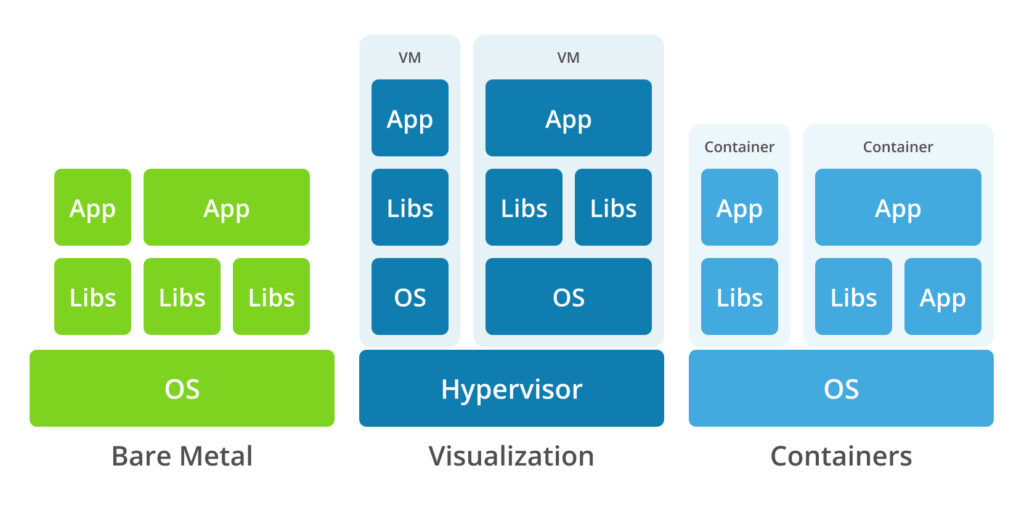Kubernetes is an open source platform developed by Google engineers to serve internal needs which has managed to become a standard in container orchestration and is actively used by developers to manage clusters of containerised applications and services. What is Kubernetes for? More details on how it works and how it is used are described in this article.
Basic Concepts
In order to understand what Kubernetes is (translated as “navigator” or “helmsperson”), it is necessary to understand the basic concepts. For example, the platform itself is abbreviated as K8s. Orchestration is a software technology for automated management of containers. Containers themselves are environments for performing isolated processes, with the files to run them contained in a single image. Containers are not linked to hardware, so they can be easily transferred between physical hardware, clouds, and operating systems.
Kubernetes and containers are inextricably linked to development. It is through containerisation that developers can isolate applications in different environments with little or no change, making development, deployment and management easier, more flexible and more understandable. Kubernetes supports the following containers: Docker, containerd, CRI-O, and others with CRI interface (Container Runtime Interface).
Kubernetes in simple words. It is a platform that makes it possible not only to simplify the configuration and management of container applications but also to automate various activities involving them: deployment, monitoring, and scaling. Before the container era, which is now strongly associated with Kubernetes, it was impossible to delineate scope for separate applications, causing them to affect each other’s performance (most often they slowed down the performance of their “neighbours”). Although the problem was solved by spreading applications across different physical servers, this was costly both in terms of capital expenditures and subsequent maintenance.
Colobridge’s Expert:
“The problem of separating applications can be solved in another way – by using virtualisation when several virtual machines isolated from each other are launched on the same physical hardware. However, K8s distribution takes up very little space, requires minimum resources to be deployed and runs on top of the operating system while virtualisation runs on the hardware. At the same time, it is wrong to consider these technologies to be competing. From the user’s point of view, a virtual machine is a full-fledged computer on which, in general, any number of applications can be launched. Kubernetes principles mean that a separate container is required for each application. Therefore, it is not reasonable to compare K8s with virtualisation because they are designed for different tasks. Besides, many companies do not immediately rush to use Kubernetes even when there are clear “indications” for this for one trite reason: it takes expensive DevOps engineers to maximise the efficiency of using dynamically scalable containerisation systems”.
The difference between deploying an application on “bare metal”, in a virtual machine, and in Kubernetes:

Why Kubernetes: key benefits
At one point in time, Kubernetes platform revolutionized application management. Now Kubernetes platform not only remains in demand, but also demonstrates rapidly growing popularity. It once became one of the fastest-growing open-source projects. By 2030, according to Research and Markets, global Kubernetes market size will reach $7.8 billion with a compound annual growth rate of 23.4% According to Oracle, more than 50% of Fortune 100 companies (top 100 largest U.S. companies) use this platform).
Some more interesting figures about Kubernetes according to GitHub, Pepperdata, Portwox:
- There are 103,000 “stars” and more than 4,000 distributor companies on GitHub as of the moment this article was published.
- It is the leader among open-source platforms for working with containers.
- It is used by 91% of companies participating in CNCF (Cloud Native Computing Foundation).
- Kubernetes helps more than 77% of users save money on cloud resources.
Today, Kubernetes is de facto considered the best platform for deploying microservice infrastructure and cloud applications. This has been made possible due to a number of advantages.
Managing microservices flexibly. Kubernetes makes it possible to build an application based on a large number of microservices in a short time, as if it were Lego cubes. In simple terms, any of them can be extracted, tested, modified in terms of functionality, and then placed back again.
Accelerating development and production. Kubernetes makes it easy for Development and Operations to collaborate. K8s automation level reduces the amount of time developers spend working with infrastructure, allowing them to spend more time on actual coding.
Using computational resources efficiently. This is possible by scaling clusters automatically, which in turn can be placed either with the same provider or with different providers.
Easily migrating to cloud platforms and between providers. According to VMware, For almost 40% of companies, simplified migration to the cloud was one of the most important arguments in favour of choosing Kubernetes.
What doesn’t Kubernetes allow you to do? For example, it cannot be called a PaaS solution (“Platform as a Service”) per se, it does not provide services for applications as middleware, it does not have built-in monitoring and logging tools, and it does not assemble applications.
How to Work with Kubernetes
As K8s is open source and has free versions, it is available to absolutely every company. However, the company can choose exactly how to use this platform. The simplest and most obvious options are either to use their own preconfigured solution to work with Kubernetes, or to rent K8s infrastructure from a provider (so-called Managed Kubernetes). While engineers who have the corresponding competencies are still required in the first scenario, in the second one, the provider and its team take care of the entire infrastructure – this is Kubernetes as a Service model.
Colobridge Expert:
“Our customers can deploy K8s and use it to suit their needs. To do so, they will need a certain set of services and most importantly, as mentioned above, a team of DevOps engineers that can maintain and regularly update the platform. This approach is not the most popular one particularly since there is not enough qualified staff, but it is a quite realistic scenario for technology companies that are actively developing and testing various applications. It makes sense for them to use K8s – they work with a lot of microservices that need to be managed, such companies have certain requirements for the availability of microservices, and such businesses have a lot of development teams that regularly need computing resources for deployment and testing. In such a case, the orchestrator scenario is entirely justified and Kubernetes is the perfect match for that role”.
To optimise the use of hardware resources on Colobridge platform, you can use virtualisation (Microsoft Hyper-V or VMware products) or you can deploy Kubernetes yourself on rented hardware (Dedicated) or your own hardware placed in our data centres. Contact our technical experts to get help in choosing the best possible solution for your specific IT workloads.

